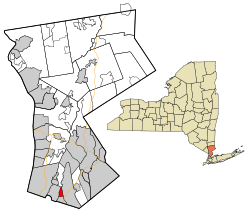Pelham (village), New York
| Village of Pelham, New York | |
|---|---|
| Village | |
| Nickname(s): Pelham Village | |
 Location of Pelham (village), New York |
|
| Coordinates: 40°54′38″N 73°48′27″W / 40.91056°N 73.80750°WCoordinates: 40°54′38″N 73°48′27″W / 40.91056°N 73.80750°W | |
| Country | United States |
| State | New York |
| County | Westchester |
| Area | |
| • Total | 0.8 sq mi (2.1 km2) |
| • Land | 0.8 sq mi (2.1 km2) |
| • Water | 0.0 sq mi (0.0 km2) |
| Elevation | 72 ft (22 m) |
| Population (2010) | |
| • Total | 6,910 |
| • Density | 8,600/sq mi (3,300/km2) |
| Time zone | Eastern (EST) (UTC-5) |
| • Summer (DST) | EDT (UTC-4) |
| ZIP code | 10803 |
| Area code(s) | 914 |
| FIPS code | 36-57001 |
| GNIS feature ID | 0960106 |
| Website | http://www.pelhamgov.com |
The Village of Pelham is a village in Westchester County, New York, United States. The population was 6,910 at the 2010 census. It is located in the Town of Pelham, which is colloquially referred to as Pelham.
On June 27, 1654, Thomas Pell purchased 9,166 acres (37.09 km2) from the Native American tribe of the Siwanoys. The purchase included an area which is known today as Pelham, New Rochelle, and portions of Bronx County. Among the land that he purchased, of course, was all the land that constitutes today's village of Pelham. Upon his death in 1669, Thomas Pell left the land to his nephew and sole heir, John Pell.
The original Village of Pelham was incorporated in 1896, bounded by the New Haven Railroad's main line to north, Colonial Avenue to the south, New Rochelle to the east, and the Hutchinson River to the west. The Village of North Pelham was incorporated on August 29, 1896. Its boundaries were the New Haven Railroad to the south, New Rochelle to the east and northeast, and the Hutchinson River to the west and northwest. By 1940, the Village of Pelham's population was 1,918 and the Village of North Pelham had a population of 5,046. In June 1975, the Village of North Pelham merged with the existing Village of Pelham.
According to the United States Census Bureau, the village has a total area of 0.8 square miles (2.1 km²), all of it land.
As of the census of 2000, there were 6,400 people, 2,287 households, and 1,687 families residing in the village. The population density was 7,785.5 people per square mile (3,013.5/km²). There were 2,337 housing units at an average density of 2,842.9 per square mile (1,100.4/km²). The racial makeup of the village was 83.22% White, 6.66% Black or African American, 0.09% Native American, 4.95% Asian, 2.47% from other races, and 2.61% from two or more races. Hispanic or Latino of any race were 7.20% of the population.
...
Wikipedia
